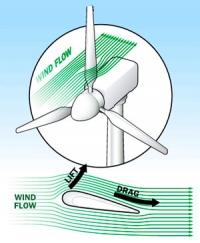Turbine Aerodynamics- Wind Turbine Alternator


Unlike the old-fashioned Dutch windmill design, which relied mostly on the wind’s force to push the blades into motion, modern turbines use more sophisticated aerodynamic principles to capture the wind’s energy most effectively. The two primary aerodynamic forces at work in wind-turbine rotors are lift, which acts perpendicular to the direction of wind flow; and drag, which acts parallel to the direction of wind flow.
Turbine blades are shaped a lot like airplane wings — they use an airfoil design. In an airfoil, one surface of the blade is somewhat rounded, while the other is relatively flat. Lift is a pretty complex phenomenon and may in fact require a Ph.D. in math or physics to fully grasp. But in one simplified explanation of lift, when wind travels over the rounded, downwind face of the blade, it has to move faster to reach the end of the blade in time to meet the wind travelling over the flat, upwind face of the blade (facing the direction from which the wind is blowing).
Since faster moving air tends to rise in the atmosphere, the downwind, curved surface ends up with a low-pressure pocket just above it. The low-pressure area sucks the blade in the downwind direction, an effect known as “lift.” On the upwind side of the blade, the wind is moving slower and creating an area of higher pressure that pushes on the blade, trying to slow it down. Like in the design of an airplane wing, a high lift-to-drag ratio is essential in designing an efficient turbine blade. Turbine blades are twisted so they can always present an angle that takes advantage of the ideal lift-to-drag force ratio.
Aerodynamics is not the only design consideration at play in creating an effective wind turbine. Size matters — the longer the turbine blades (and therefore the greater the diameter of the rotor), the more energy a turbine can capture from the wind and the greater the electricity-generating capacity. Generally speaking, doubling the rotor diameter produces a four-fold increase in energy output. In some cases, however, in a lower-wind-speed area, a smaller-diameter rotor can end up producing more energy than a larger rotor because with a smaller setup, it takes less wind power to spin the smaller generator, so the turbine can be running at full capacity almost all the time.
Tower height is a major factor in production capacity, as well. The higher the turbine, the more energy it can capture because wind speeds increase with elevation increase — ground friction and ground-level objects interrupt the flow of the wind. Scientists estimate a 12 percent increase in wind speed with each doubling of elevation.
